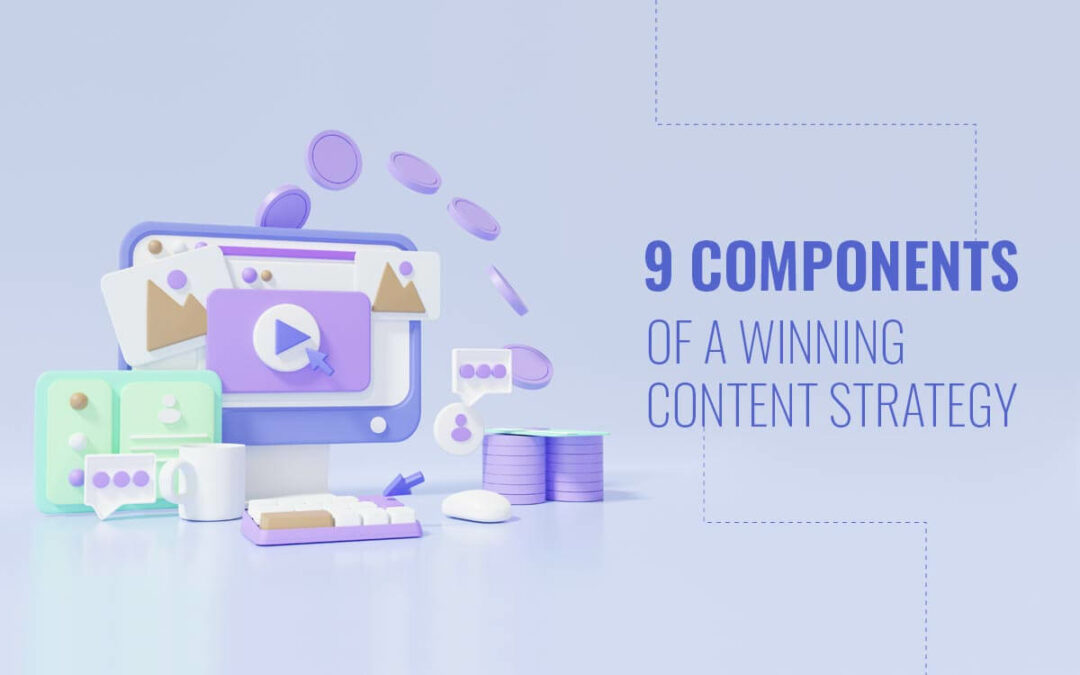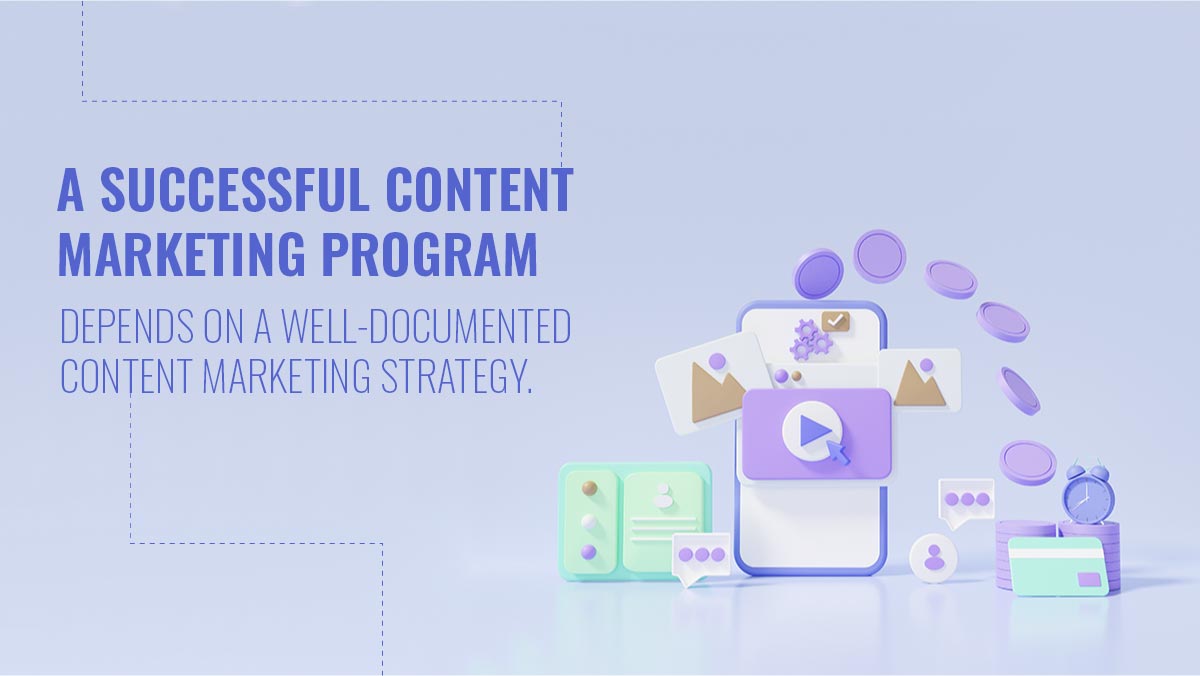You’ve probably heard the saying, “Content is king.” It comes from an essay Bill Gates wrote in 1996, and it seems to ring just as true these days.
The rise of smartphones has led to people consuming content in record numbers. Since the pandemic began in 2020, the average person spends nearly 7 hours per day consuming content. Most of us have 24/7 access to the internet and social media at our fingertips and more downtime than ever to browse.
This has created a unique opportunity for content marketers. While there’s a lot of noise to compete against online, it’s easier than ever to get lots of eyes on your business. However, going viral or getting lots of views isn’t enough. Your content marketing also needs to compel users to become customers or fans.
Ultimately, reaching your business goals through your marketing efforts comes down to content strategy.
What Is Content Strategy?
Content strategy is your complete plan when it comes to content creation and distribution. It should encompass all the ways you can get your company in front of potential customers. As we go deeper into the article, we’ll discuss all the facets that make up a successful content strategy.
But, first, let’s explore a few of the reasons why having a strong content marketing strategy is so important.
The Importance of a Content Marketing Plan
Content marketing can be expensive. For instance, running online ads or printing direct mail pieces can cost thousands of dollars. You don’t want to be taking a shot in the dark with that kind of investment. Depending on your budget, you may not even have any leeway to take risks.
That’s where content strategy comes in. The goal of your content marketing plan is to generate more business. When you have a solid plan in place, you’re much more likely to achieve that. Doing research and proper planning allows you to create high-quality content targeted at the right audience.
Search engine algorithms are also more advanced than ever before. They rank for completeness and relevancy, among many other things. If you pump out subpar content with no strategy, you will confuse the algorithms. If you don’t impress the algorithms, you won’t appear at the top of the search engine results pages (SERPs). And your content is no good if no one ever sees it.
Having a well-thought-out content marketing strategy ensures you’ll have a record of your marketing efforts. You’ll be able to evaluate what you’ve done and how and why it worked (or didn’t). These insights lead to better planning and budgeting for the future.
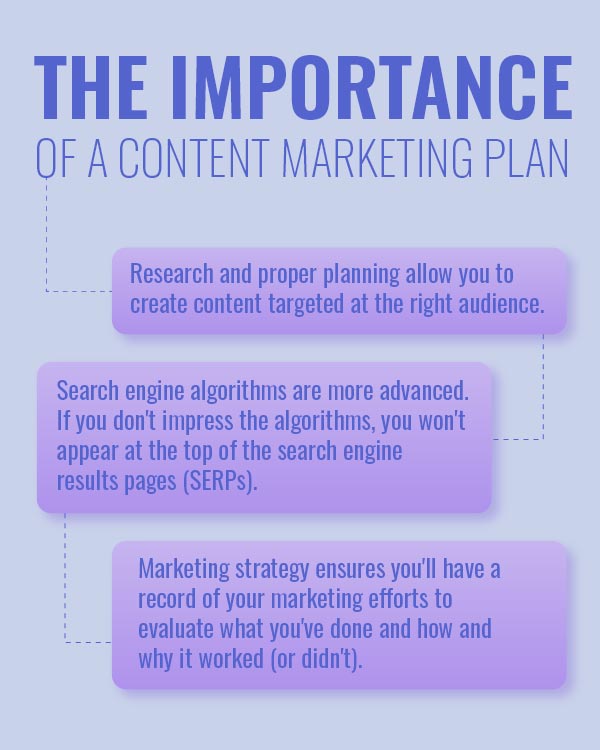 The Elements of a Successful Content Marketing Strategy
The Elements of a Successful Content Marketing Strategy
Now that we’ve clarified why a content marketing strategy is so important, let’s talk about what goes into a good one. Here are nine practical tips successful content marketers will agree you should keep in mind.
1. Setting clear goals.
What is the purpose of your content? This is the number one question you should ask yourself as you set out to create a content marketing plan. Your goals will end up dictating the rest of the strategic decisions you need to make.
Remember that different pieces of content may have different goals. For example, the goal of a blog post may be to generate brand awareness while the goal of a digital ad is to drive sales.
Key Performance Indicators (KPIs)
Once you’ve established your content marketing goals, you also need to define what successfully reaching them looks like. Think about various metrics you can track for each goal and what you’d like to achieve. Research standards within your industry and among your competitors.
Having clear KPIs from the outset can help you stay on track as you put your content marketing plan into action. As you start distributing content, your KPIs can help you see what’s working well and what isn’t.
2. Defining your audience.
During the content-creation process, you need to have a clear idea of whom you’re talking to. Think of it this way: You wouldn’t speak to a teenage girl the same way you’d speak to, say, a retired doctor. Having a clearly defined audience will guide the tone and design of your content.
Buyer Personas/Customer Avatars
It’s wise to create buyer personas (also known as customer avatars). A buyer persona is a character you invent that is representative of your ideal customer. If your business caters to various market segments, you should create an avatar for each.
Consider the following questions when developing your buyer personas:
- How old is your ideal customer?
- What gender do they identify as?
- Are they married or single?
- Do they have kids?
- What do they do for a living?
- How do they spend their free time?
- What are their interests and hobbies?
- What do they struggle with?
- What wants and needs do they have?
By the end of this list, you should have a pretty strong idea of who this customer is. You should even give each persona a name. Your content marketing campaigns should be designed and written as if you are speaking directly to that person.
3. Choosing the right platforms.
Once you have a good idea of who your customer is, you need to figure out how to reach them. What are their habits and where do they hang out? Think about their behavior both online and out in the world.
You might already have these answers from the work you did on your buyer personas. If not, do some demographic research. Find out which social media channels your ideal customers prefer and how they use them. Learn where they spend their time.
Another good way to go about this is by doing competitive research. How are your biggest rivals approaching content marketing? Note which platforms and content formats they favor. If your competitors are successful and have been using a certain strategy for a while, it’s likely working.
On the flip side, you should also keep track of what content doesn’t perform as well for them. That way, you can avoid spending time on that type of content marketing. Look for gaps as well. If there’s a platform your customers are using that your competitors haven’t adopted yet, get there first.
Finally, you should also consider how to best showcase your brand and products. Certain platforms will lend themselves better to your content than others. If you rely on visuals, you may want to focus on photo and video apps, like Instagram, TikTok, YouTube, and Pinterest. If you plan on producing primarily written content, LinkedIn, Facebook, and Twitter may be more suitable.
Beyond social media strategy, consider all the other places you can produce content. Online, that may include websites and landing pages, blogs, and email marketing. Your content marketing strategy may also comprise printed materials and signage.
4. Identifying target keywords.
Driving organic traffic is a huge component of content marketing strategy. Company growth can be largely dependent on your reach. How many people are you getting in front of?
And it’s not just about the number of people. They also have to be the right kind of people, namely prospective customers. To figure out how to reach the right segments of the population, evaluate your buyer’s journey. What kind of questions does your target audience have at each stage?
Do research on each of these questions and topics to identify the search trends. Also look at the SERPs to see what’s ranking well. If you can create a better version of that content, you could nab a top spot.
If you’re in a saturated market with tough competition for all the most popular keywords related to your industry, all is not lost. Shift your focus to creating relevant content for long-tail keywords instead.
Long-tail keywords are longer and more specific search phrases. They won’t see the same high traffic numbers as broader terms, but there will be less competition. Often, people searching for these terms may be further along in the customer journey as well. If you can become the top result for many long-tail keywords, it may end up paying off more than getting to the sixth or seventh spot for a more popular term.
5. Performing a content audit.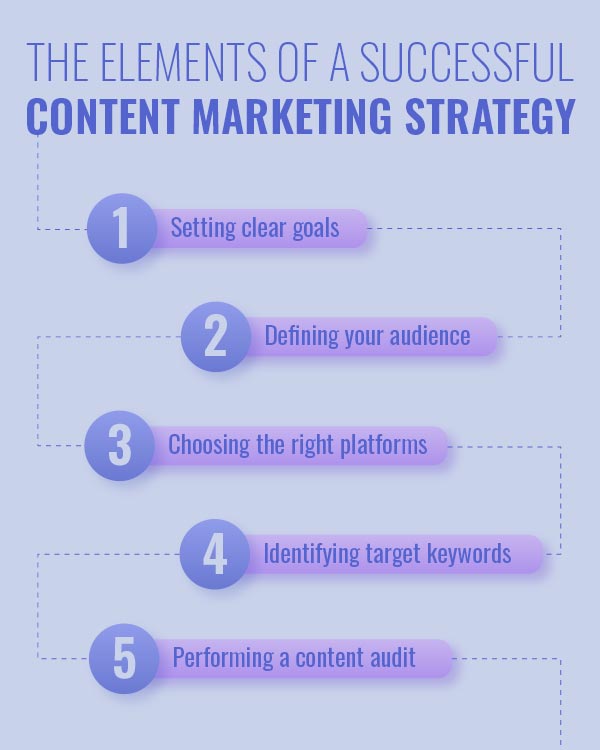
Unless your company is brand new, you probably already have some content. Your new content marketing strategy may go in a new direction, but your old content still has value. Before hiring new content team members or wiping the slate clean on your existing platforms, do a content audit.
A content audit consists of reviewing and cataloging all the pieces of content your organization has at its disposal. This includes content you’ve produced as well as user-generated content, like customer feedback and testimonials.
Remember to record any corresponding performance data as well, such as traffic numbers or conversion rates. If you have existing content that’s performed well, you may be able to optimize and repurpose it to enhance its value.
There are myriad ways to stretch each piece of content. Infographics and quotes from blogs can become social media posts. A podcast episode can be transcribed into a blog post or quoted for social captions. Various pieces of content can be compiled into master guides or landing pages.
6. Building a content calendar.
Based on the research you’ve done so far, you should have some idea of the content formats you need to focus on. Let’s explore some of the most popular types and how they can fit into your content strategy.
Content Formats
Blog Articles
Adding a blog to your website can help you with your search engine optimization (SEO) efforts. Search engines love long and informative articles. Getting ranked for relevant keywords will drive significant website traffic. Top-notch content and high ranking will also build your authority within your industry.
Downloads/Lead Magnets
Offering downloadable content on your website can be a great way to generate leads. Some popular examples of this type of content include ebooks, case studies, templates, and checklists.
You can gate this content behind a form that collects the user’s email address and consent to receive communications from you. It’s a win-win: Your audience gets something valuable for free, and you get to build your email list.
Emails
Email marketing is one of the most important elements of content strategy. It is believed to be the most effective way to reach your target audience. It makes sense; consumers who were willing to give you their email address already know and trust you.
Lead-nurture campaigns, newsletters, and abandoned cart emails are a few of the basic email marketing tactics you can try.
Social Media Posts
Base your social media strategy on the content channels you decided to focus on earlier. Within social media, there are many different kinds of content you can post. You will need graphics, photography, videos, and copy. Make sure to consider production time when mapping out your posting schedule.
Podcasts
Podcasting is one of the newest but fastest-growing content outlets. It is less competitive than the blog and video spaces, which have been around a lot longer. It’s not the right fit for every niche, but if your industry lends itself to podcasting, it may be an interesting avenue to explore.
Collaborative Tools and Systems
Once you’ve mapped out which content types you’ll be using, you need to create a content production system.
Content Management Systems and Project Management Platforms
Consider the various types of content you’ll need and which content teams will need to be involved in creation. Make sure you choose content management systems and project management platforms that make things easy. Many of these platforms are affiliated with each other, which facilitates integration.
It may make sense to have separate editorial calendars by platform, such as one for blog posts and one for each social channel. However, you should also have a master editorial calendar that accounts for all content distribution. This helps you ensure that your content marketing strategy is aligned across all platforms.
Automations/Schedulers
A content marketing strategy is very comprehensive. There is a lot to manage and execute on any given day. Help your teams work most efficiently by utilizing automated processes wherever you can. Many integrations and plug-ins exist to make processes more seamless. For instance, your CMS may have plug-ins that allow you to pull in content from your social media accounts.
There are also platforms that allow for automated content posting across many social channels. This helps to avoid having to log in and post on each one separately. Plus, scheduling options mean you can have posts go up in the optimal time window for each window. This translates to a lot of time saved.
7. Implementing SEO best practices.
As you create content, keep SEO best practices in mind. Your content marketing efforts will only pay off if your content gets seen. Knowing and implementing SEO tactics increases your chances of growing your organic traffic.
Internal and External Linking
Think of each piece of your content as a piece of a larger system. You want users to see value in your content. One way to do this is to link it to other related pieces.
Internal links are those that drive the user to another page within your own site. External links go to another website. Internal links are often best because they will keep website visitors on your site for longer.
However, external links can be a great way to build credibility. They show that you’ve done your research and that your claims are backed by others. Just make sure that you don’t link to any of your competitors.
Another benefit of external linking is that the sources you link to may notice you are linking to them. Then, in turn, they may link back to you. Their link back to you is known as a backlink. Getting backlinks from other reputable sites also boosts your ability to rank well.
Keywords
As mentioned earlier, keyword research is a very important piece of content marketing strategy. Opportunity lies in identifying popular terms that don’t yet have many high-quality results. When creating content, work that term into your headlines and throughout your piece.
You shouldn’t have to think about this too hard. If you do a good job researching and writing an article on the topic, you should naturally include the right keywords.
Structure
When search engines scan content, they want to make sure that the article is set up in a logical way. One way they do this is by examining the structure of a piece.
You shouldn’t write giant blocks of text. Split content up into sections and subsections, and use bulleted or numbered lists. For long content, you may also want to include a table of contents at the top of the page that links down to each section.
Format headlines using HTML headings (or H tags). The main title should have the H1 tag. Section headlines within your piece should get an H2 tag. Subsection headlines within those should get an H3 tag, and so on.
Length
Another factor to consider is the length of your pieces. Optimized content covers the topic at hand in a detailed manner. It’s a waste of time to write short, 300-word posts on topics your competitors have 3,000-word guides about. Strive to outdo the quality of the content currently available in your space.
There are also optimal post lengths for social media content. Make sure you know the standards for each platform you choose to build a presence on.
Media
Video content has been on the rise for several years. Users like interactive, dynamic content. Create compelling content with imagery and video. Visual content is more shareable across social media. When your content is shared more, your reach increases.
8. Promoting your content.
A content marketing strategy only succeeds if the content reaches its target audience. Employing SEO tactics will help drive organic search traffic, but there is more you can do to increase reach.
Earning Backlinks
We briefly touched on backlinks in the previous section. Companies often track links to their content and may link back to your content in return. But you don’t have to passively hope this happens.
Instead, do some active outreach. If you’ve quoted a source in your post, tag them or send them a message about the piece. If your piece includes updated research, locate older, existing content by non-competitors. Reach out to them and let them know they are welcome to link to your brand-new research.
You can also create some of your own backlinks by linking between your various platforms. For example, if you write a blog post, you would also want to publish posts on your social media that link back to it.
Generating Traffic
Each backlink helps you generate more traffic, but there are even more ways to expand your audience.
Collaborations and partnerships are a great way to get in front of new people. A strategic way to do this is to think about products or services adjacent to the ones you offer. Find companies in those fields, and pitch them an idea to collaborate. A few ideas include guest blogging, podcast interviews, and going live on social media together.
Journalists are also always looking for interesting stories to cover. Submit your pieces to local, regional, or national news outlets. Just keep in mind that large-scale news coverage can bring a lot of attention to you at once. Make sure you have the capacity to handle high levels of traffic, orders, and inquiries before going this route.
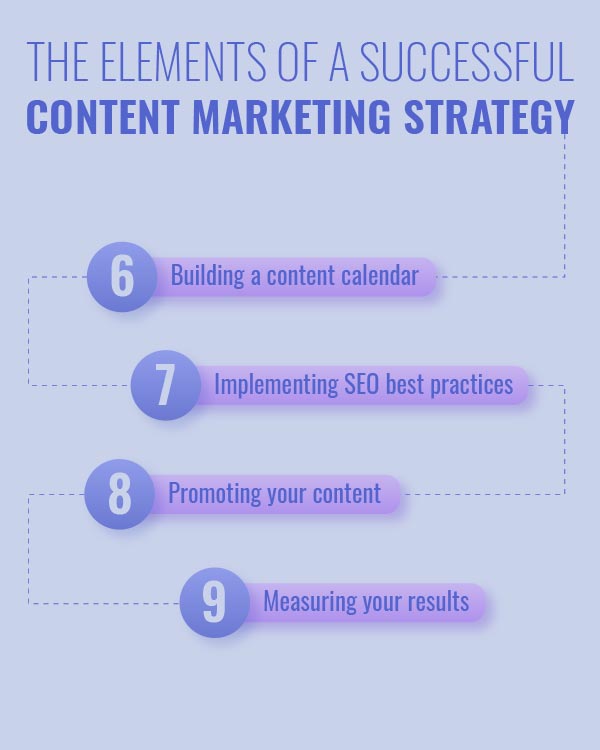 9. Measuring your results.
9. Measuring your results.
Being able to track your content analytics is a critical element of content marketing strategy. Make sure you have the right tools and systems in place to assess your results. You need to know what’s working in order to iterate and budget for the future.
Google Analytics and In-App Reporting
Google Analytics is one of the most useful services for tracking user behavior on your website. It provides insight on everything from your traffic to conversions to backlinks. Many social media platforms also provide tracking and metrics if you have a business account.
Check your metrics regularly to determine if your content marketing strategy is working as intended. Identifying trends will help you when it comes to creating content in the future. Learning what pieces perform well and why can help you attract leads consistently.
Conclusion
A successful content marketing program depends on a well-documented content marketing strategy. Build your own content marketing strategy based on your business goals the type of content marketing that best suits your products and services.
Your content program should deliver content to your target audience consistently. And each piece of content should have a clear value proposition to convert leads. After all, your content marketing strategy only succeeds if it focuses on lead generation and provides a return on investment.
FAQs About Content Strategy
Check out a few of the most frequently asked questions about content marketing strategy.
What are the basic contents of a marketing plan?
A good marketing plan will encompass a description of your product or service, your target audience, your business goals, a market analysis, your budget, and a content marketing strategy.
What is included in a content strategy?
Content strategy includes marketing goals and KPIs, buyer personas, content platforms, keyword research, content team resources, editorial calendars, digital tools, reporting, and distribution methods.
How do you create a content marketing strategy?
To create a content marketing strategy, assess your business goals and marketing budget, do competitive analysis and market research, and conduct a content audit. Based on your findings, you should identify necessary content resources and create an editorial calendar that encompasses all types of content you intend to produce and promote. Your strategy should also include KPIs and reporting methods so you can track your results.
Why do marketers need to create a content marketing strategy?
Content marketing strategies allow marketers to create content with intention. Otherwise, marketing campaigns will lack focus and have no clear objectives. Without a strategy, it’s hard to predict the outcome of content creation. As a result, budgeting and forecasting will also be more difficult for your content marketing efforts.
